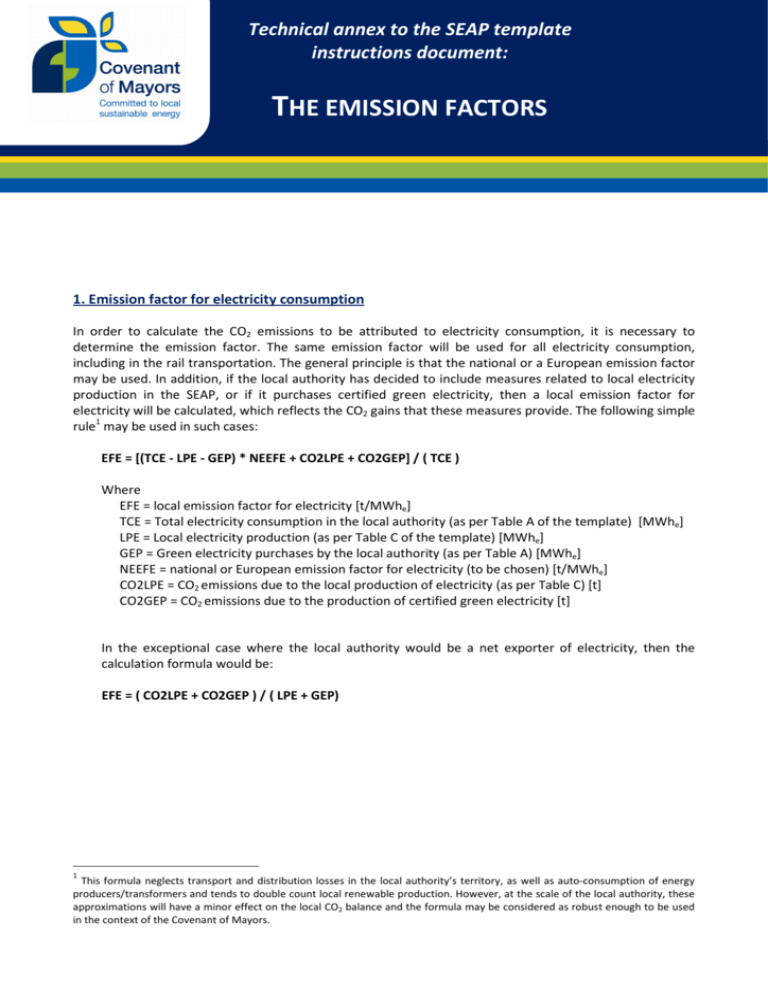the emission factors
advertisement

Technical annex to the SEAP template instructions document: THE EMISSION FACTORS 1. Emission factor for electricity consumption In order to calculate the CO2 emissions to be attributed to electricity consumption, it is necessary to determine the emission factor. The same emission factor will be used for all electricity consumption, including in the rail transportation. The general principle is that the national or a European emission factor may be used. In addition, if the local authority has decided to include measures related to local electricity production in the SEAP, or if it purchases certified green electricity, then a local emission factor for electricity will be calculated, which reflects the CO2 gains that these measures provide. The following simple rule1 may be used in such cases: EFE = [(TCE - LPE - GEP) * NEEFE + CO2LPE + CO2GEP] / ( TCE ) Where EFE = local emission factor for electricity [t/MWhe] TCE = Total electricity consumption in the local authority (as per Table A of the template) [MWhe] LPE = Local electricity production (as per Table C of the template) [MWhe] GEP = Green electricity purchases by the local authority (as per Table A) [MWhe] NEEFE = national or European emission factor for electricity (to be chosen) [t/MWhe] CO2LPE = CO2 emissions due to the local production of electricity (as per Table C) [t] CO2GEP = CO2 emissions due to the production of certified green electricity [t] In the exceptional case where the local authority would be a net exporter of electricity, then the calculation formula would be: EFE = ( CO2LPE + CO2GEP ) / ( LPE + GEP) 1 This formula neglects transport and distribution losses in the local authority’s territory, as well as auto-consumption of energy producers/transformers and tends to double count local renewable production. However, at the scale of the local authority, these approximations will have a minor effect on the local CO2 balance and the formula may be considered as robust enough to be used in the context of the Covenant of Mayors. The national and European emission factors are presented below National and European emission factors for consumed electricity Country Austria Belgium Germany Denmark Spain Finland France United Kingdom Greece Ireland Italy Netherlands Portugal Sweden Bulgaria Cyprus Czech Republic Estonia Hungary Lithuania Latvia Poland Romania Slovenia Slovakia EU-27 Standard emission factor (t CO2/MWhe) 0.209 0.285 0.624 0.461 0.440 0.216 0.056 0.543 1.149 0.732 0.483 0.435 0.369 0.023 0.819 0.874 0.950 0.908 0.566 0.153 0.109 1.191 0.701 0.557 0.252 0.460 LCA emission factor (t CO2-eq/MWhe) 0.310 0.402 0.706 0.760 0.639 0.418 0.146 0.658 1.167 0.870 0.708 0.716 0.750 0.079 0.906 1.019 0.802 1.593 0.678 0.174 0.563 1.185 1.084 0.602 0.353 0.578 2. Emission factors for local renewable electricity production or green electricity purchases The following values may be used: Emission factors for local renewable electricity production Electricity source Solar PV Windpower Hydropower Standard emission factor (t CO2/MWhe) 0 0 0 LCA emission factor (t CO2-eq/MWhe) 0.020-0.050 0.007 0.024 3. Emission factor for heat/cold consumption If heat or cold is sold/distributed as a commodity to end users within the local authority (see Table A of the template), then it is necessary to establish the corresponding emission factor. If a part of the heat/cold that is produced in the local authority is exported, then the corresponding share of CO2 emissions should be deducted when calculating the emission factor for heat/cold production (EFH), as indicated in the formula below. In a similar manner, if heat/cold is imported from a plant situated outside the local authority, then the share of CO2 emissions of this plant that correspond to heat/cold consumed in the territory of the local authority should be accounted for when calculating the emission factor (see formula below). The following formula may be applied, that allows taking those issues into consideration. EFH = (CO2LPH + CO2IH – CO2EH) / LHC Where EFH = emission factor for heat [t/MWhheat] CO2LPH = CO2 emissions due to the local production of heat (as per Table D of the template) [t] CO2IH = CO2 emissions related to any imported heat from outside the territory of the local authority [t] CO2EH = CO2 emissions related to any heat that is exported outside of the territory of the local authority [t] LHC = Local heat/cold consumption (as per Table A of the template) [MWhheat] A similar formula may apply for cold. 4. Emission factors for fuel combustion The following emission factors may be used for fuel combustion (including in the case of local production of heat or electricity). Standard CO2 emission factors (from IPCC, 2006) and CO2-equivalent LCA emission factors (from ELCD) for most common fuel types Type Motor Gasoline Gas oil, diesel Residual Fuel Oil Anthracite Other Bituminous Coal Sub-Bituminous Coal Lignite Natural Gas Municipal Wastes (non-biomass fraction) Wood2a a2 Standard emission factor [t CO2/MWh] 0.249 0.267 0.279 0.354 0.341 0.346 0.364 0.202 0.330 0 – 0.403 LCA emission factor [t CO2-eq/MWh] 0.299 0.305 0.310 0.393 0.380 0.385 0.375 0.237 0.330 0.002b – 0.405 Lower value if wood is harvested in a sustainable manner, higher if harvesting is unsustainable. The figure reflects the production and local/regional transport of wood, representative for Germany, assuming: spruce log with bark; reforested managed forest; production mix entry to saw mill, at plant; and 44% water content. The local authority using this emission factor is recommended to check that it is representative for the local circumstances and to develop an own emission factor if the circumstances are different. b Plant oil Biodiesel Bioethanol Solar thermal Geothermal 0c 0c 0c 0 0 0.182d 0.156e 0.206f -h -h For further information, please consult the Part II of the SEAP Guidebook c Zero if the biofuels meet sustainability criteria; fossil fuel emission factors to be used if biofuels are unsustainable. Conservative figure regarding pure plant oil from palm oil. Note that this figure represents the worst ethanol plant oil pathway and does not necessarily represent a typical pathway. This figure does not include the impacts of direct and indirect land use change. Had these been considered, the default value could be as high as 9 t CO2-eq/MWh, in the case of conversion of forest land in the tropics. e Conservative figure regarding biodiesel from palm oil. Note that this figure represents the worst biodiesel pathway and does not necessarily represent a typical pathway. This figure does not include the impacts of direct and indirect land use change. Had these been considered, the default value could be as high as 9 t CO2-eq/MWh, in the case of conversion of forest land in the tropics. f Conservative figure regarding ethanol from wheat. Note that this figure represents the worst ethanol pathway and does not necessarily represent a typical pathway. This figure does not include the impacts of direct and indirect land use change. Had these been considered, the default value could be as high as 9 t CO2-eq/MWh, in the case of conversion of forest land in the tropics. h Data not available, but emissions are assumed to be low (however the emissions from electricity consumption of heat pumps is to be estimated using the emission factors for electricity). Local authorities using these technologies are encouraged to try to obtain such data. d






